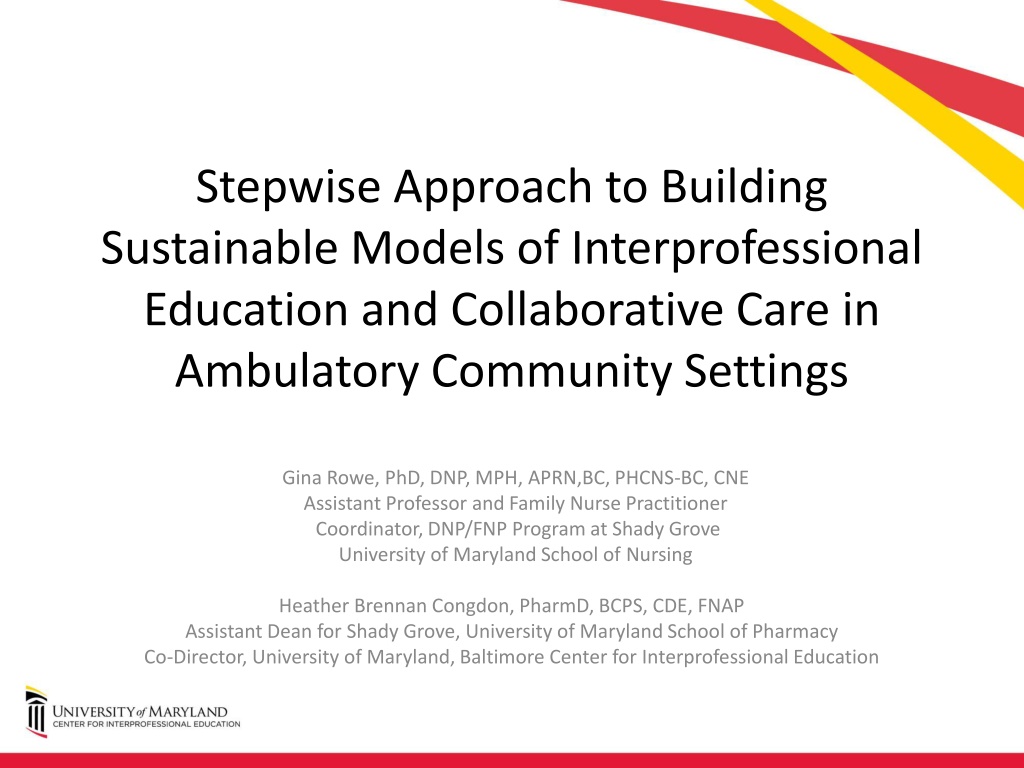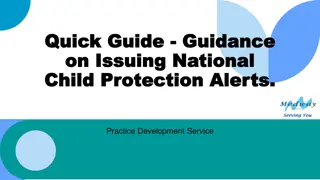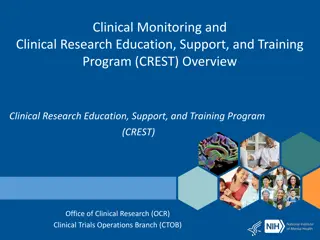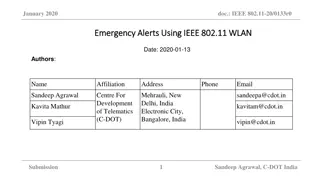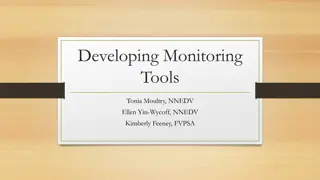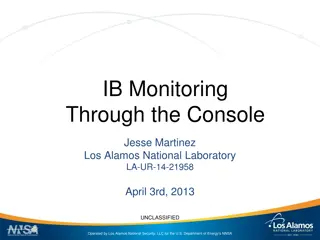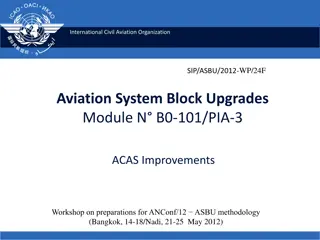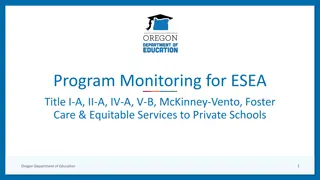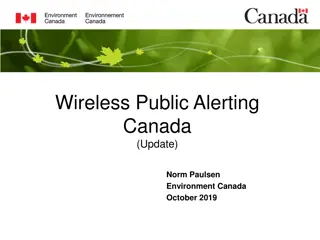Set up Alerts on ParentPay for Easy Monitoring
Keep track of your school dinner balances and payments effortlessly by setting up alert notifications on ParentPay. Learn how to enable Balance Alerts and New Items Alerts, receiving them via email or text messages. Follow simple steps within your ParentPay account to stay in control of your finances and get notified about new activities. Take advantage of this convenient feature and ensure timely updates on your child's account activities.
Download Presentation

Please find below an Image/Link to download the presentation.
The content on the website is provided AS IS for your information and personal use only. It may not be sold, licensed, or shared on other websites without obtaining consent from the author.If you encounter any issues during the download, it is possible that the publisher has removed the file from their server.
You are allowed to download the files provided on this website for personal or commercial use, subject to the condition that they are used lawfully. All files are the property of their respective owners.
The content on the website is provided AS IS for your information and personal use only. It may not be sold, licensed, or shared on other websites without obtaining consent from the author.
E N D
Presentation Transcript
Stepwise Approach to Building Sustainable Models of Interprofessional Education and Collaborative Care in Ambulatory Community Settings Gina Rowe, PhD, DNP, MPH, APRN,BC, PHCNS-BC, CNE Assistant Professor and Family Nurse Practitioner Coordinator, DNP/FNP Program at Shady Grove University of Maryland School of Nursing Heather Brennan Congdon, PharmD, BCPS, CDE, FNAP Assistant Dean for Shady Grove, University of Maryland School of Pharmacy Co-Director, University of Maryland, Baltimore Center for Interprofessional Education
Involved IPE Team at the Universities at Shady Grove Barbara Nathanson, MSW, LCSW-C Katherine J. Morris, MSW, LCSW-C Joan Pittman, PhD, MSW, LCSW-C Jana Goodwin, PhD, RN, ANCP Rebecca Wiseman, PhD, RN
Objectives Interprofessional Education (IPE) Definitions Rationale/drivers Stepwise Progression in Montgomery County Mercy Health Clinic Holy Cross Hospital Outpatient Clinics National Center Training and Future Progression
IPE IS NOT Students from different health professions in the same classroom without reflective interaction. Pharmacy student Nursing student Medical student Social Work student
IPE IS NOT A faculty member from one profession leading a classroom learning experience for students of another profession. Pharmacy professor Social Work students
IPE IS NOT A session in a patient care setting led by an individual from another profession without sharing of decision making or responsibility for patient care. Nursing professor Patient Pharmacy students
IPE IS When two or more professions learn with, from, and about each other to improve collaboration and the quality of care. Centre for the Advancement of Interprofessional Education, UK Picture credit: http://www.aippen.net
IPE IS Educators and learners from two or more health professions and their foundational disciplines who jointly create and foster a collaborative learning environment. 2005-2006 AACP COF Interprofessional Education Task Force
What Drives Interest in IPE? Health professionals expected to work in teams But students rarely taught how to do so in school Potential to influence healthcare quality, costs, and outcomes Reeves, S., et al. (2016). BEME systematic review of the effects of interprofessional education Bradley, E.H. and Taylor, L.A. (2013). The American health care paradox: Why spending more Is getting us less. New York, NY: Public Affairs.
Organizational Interest in IPE Healthcare Environment Nursing Institute of Medicine reports To Err is Human, 1999 American Association of Colleges of Nursing Essentials of Baccalaureate (2008), Masters (2011) and Doctoral (2006) Education Institute of Healthcare Improvement Triple Aim Initiative, 2007 National Legislation Affordable Care Act, 2010 Medicare Access and CHIP Reauthorization Act (MACRA), 2015 Quality and Safety Education for Nurses Entry-level and Graduate Competencies, 2007, 2012 Accreditation Standards Professional Competencies, e.g., National Organization of Nurse Practitioner Faculty NP Core Competencies, 2012, 2017 Competencies IPEC Core Competencies NACE Competencies Institute of Medicine The Future of Nursing: Leading Change, Advancing Health, 2010
Nursing and Interprofessional Education Collaborative (IPEC) Essentials and Competencies Nursing Competencies AACN Essentials Quality improvement and safety Inter-professional communication/collaboration IPEC Competencies Values and Ethics Roles/Responsibilities Interprofessional Communication Teams and Teamwork QSEN Teamwork and collaboration Safety NONPF Competencies Collaboration and coordination Ethics
Buckets of IPE: Where Does IPE in Practice Fit? EXPOSURE IMMERSION COMPETENCE
Stepwise Approach to Sustainable Model of IPE and IPC (Competence) Start small - pilot Go slow Build upon successes Learn from pitfalls Assess! PDSA
Mercy Health Clinic One of 12 safety-net clinics in the Montgomery Care program of the Primary Care Coalition of Montgomery County Serves low income, uninsured patients Provides a variety of services Primary preventative care Diagnosis and treatment of general acute and chronic medical problems Management of chronic medication conditions Referrals for consultation
Goals of IPE Clinic at MHC To enhance and expand care for medically complex, uninsured, ethnically diverse patients through coordinated interprofessional care. To educate and train healthcare professional students from pharmacy, nursing, and social work programs at the University of Maryland, Baltimore (UMB) and the University of Maryland, Baltimore County (UMBC) to efficiently and effectively provide coordinated care through mastery of the Interprofessional Education Collaborative (IPEC) Core Competencies for Interprofessional Practice.
IPE Clinic Details IPE Clinic began in Fall 2014 Pharmacy Nursing (RN to BSN; added DNP in fall '16) Social Work (BSW and MSW) Examples of interventions made by IPE Clinic Medication and chronic condition education Medication adjustment to reach therapeutic goals Enhanced access to medication, food and clothes Referrals to specialty clinics, screening, etc.
IPE Clinic Results: Relative Frequency of Interventions Made at MHC 6% 12% 3% Total: Medication Therapy Related Change Total: Referrals Vaccinations Release of records 31% Lab work 32% Scheduling Appointments Education Assistance to obtain Medication or Treatment Screening 8% 2% 5% 1%
TSS Grymonpre, R., van Ineveld, C., Nelson, M., Jensen, F., De Jaeger, A., Sullivan, T., Weinberg, L., Swinamer, J., and Booth, A. (2010). See it Do it Learn it: Learning interprofessional collaboration in the clinical context. Journal of Research in Interprofessional Practice and Education, 1(2), 127-144. N pre N Pre Post P Survey Item post value 18 15 3.7 4.2 0.06 Function effectively in an interdisciplinary team 1 18 16 4.3 4.6 0.5 Treat team members as colleagues 2 18 16 3.7 4.6 0.003 Identify contributions to patient care that different disciplines can offer 3 18 16 3.8 4.5 0.01 Apply your knowledge to caring for a person in the team care setting 4 18 15 4 4.47 0.09 Ensure that patient/family preferences/goals are considered when developing the team s care plan 5 18 16 3.9 4.2 0.34 Handle disagreements effectively 6 17 14 3.7 4.6 0.001 Strengthen cooperation among disciplines 7 18 16 3.8 4.6 0.004 Carry out responsibilities specific to your discipline s role on a team 8 18 16 3.9 4.4 0.04 Address clinical issues succinctly in interdisciplinary meetings 9 18 16 4.1 4.4 0.33 Participate actively at team meetings 10 17 15 3.7 4.2 0.1 Develop an interdisciplinary care plan 11 15 16 3.7 4.4 0.02 Adjust your care to support the team goals 12 17 16 3.8 4.4 0.04 Develop intervention strategies that help patients attain goals 13 18 16 3.6 4.4 0.01 Raise appropriate issues at team meetings 14 16 16 3.8 4.3 0.15 Recognize when the team is not functioning well 15 18 15 3.6 4.1 0.09 Intervene effectively to improve team functioning 16 18 16 3.1 4.2 0.002 Help draw out team members who are not participating actively in meetings 17
Expanding the Pilot National Center for Interprofessional Practice and Education* grant 2016 Accelerating Interprofessional Community-Based Education and Practice Goal: Develop innovative, creative and sustainable community-based clinical initiatives to accelerate existing IPE Eligible applicants: Health/professional schools, with a history of collaboration, working with a community partner and its clients PI Graduate nursing Two additional safety-net community health center sites Narrowed focus: uncontrolled diabetes and depression/anxiety Now track A1C and PHQ-9 *HRSA Cooperative Agreement Award No. UE5HP25067; Josiah Macy Jr. Foundation, Robert Wood Johnson Foundation, Gordon and Betty Moore Foundation, John A. Hartford Foundation, University of Minnesota
Holy Cross Hospital Outpatient Clinics Gaithersburg, Montgomery County, MD Target Population: immigrant, Hispanic, uninsured or Medicaid, diagnosed with DMT2/depression Evolution: from interventions & referrals to clinical outcomes Cultural competence & care coordination
Lessons Learned To Date Successes Patient recruitment Graduate student involvement 5-6 each - nursing, pharmacy and social work students Student outcomes Patient outcomes (qualitative) Challenges Clinic staff turn-over Undergraduate student involvement 2 social work, 1 RN-BSN Standardization of student recruitment Time
Looking to the Future Expansion to 3rd health center in Fall, 2017. Larger external grants to support IPE and IPC. Expand to additional safety-net community health clinics in Montgomery County. Train clinical preceptors to replicate IPE Clinics. National Center for IPE: Interprofessional Learning IN Practice for Preceptors and Site Development
Select References American Association of Colleges of Nursing. (2011). The essentials of baccalaureate education for professional nursing practice. From: http://www.aacn.nche.edu/education-resources/BaccEssentials08.pdf American Association of Colleges of Nursing. (2006). The essentials of doctoral education for advanced nursing practice. From: http://www.aacn.nche.edu/publications/position/DNPEssentials.pdf American Association of Colleges of Nursing. (2011). The essentials of masters education in nursing. From: http://www.aacn.nche.edu/education-resources/MastersEssentials11.pdf Bradley, E.H. and Taylor, L.A. (2013). The American health care paradox: Why spending more Is getting us less. New York, NY: Public Affairs. Commonwealth Fund. (2015). U.S. healthcare from a global perspective. (2015). From: http://www.commonwealthfund.org/publications/issue-briefs/2015/oct/us-health-care-from-a-global- perspective Institute for Healthcare Improvement. (2017). The IHI Triple Aim Initiative. From: http://www.ihi.org/engage/initiatives/TripleAim/Pages/default.aspx Institute of Medicine. (2010). The Future of Nursing: Leading Change, Advancing Health. From: http://nationalacademies.org/hmd/reports/2010/the-future-of-nursing-leading-change-advancing-health.aspx Interprofessional Education Collaborative. (2016). Core competencies for interprofessional collaborative practice: 2016 Update. From: http://www.aacn.nche.edu/education-resources/IPEC-2016-Updated-Core-Competencies- Report.pdf National Organization of Nurse Practitioner Faculties. (2012). Nurse practitioner core competencies. From: http://www.nonpf.org/?page=14 QSEN Institute. (2007, 2012). QSEN competencies. From: http://qsen.org/ Reeves, S., et al. (2016). A BEME systematic review of the effects of interprofessional education: BEME guide no. 39. Medical Teacher, 38(7), 656-668.
Questions? Heather Congdon hcongdon@rx.umaryland.edu Gina Rowe rowe@son.umaryland.edu
